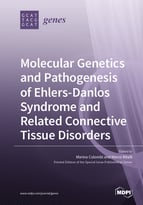Molecular Genetics and Pathogenesis of Ehlers–Danlos Syndrome and Related Connective Tissue Disorders
A special issue of Genes (ISSN 2073-4425). This special issue belongs to the section "Human Genomics and Genetic Diseases".
Deadline for manuscript submissions: closed (30 June 2019) | Viewed by 130867
Special Issue Editors
Interests: heritable connective tissue disorders; Ehlers-Danlos syndrome; arterial tortuosity syndrome; Loeys-Dietz syndrome; cutis laxa; collagen genes; extracellular matrix; fibronectin; integrins
Interests: heritable connective tissue disorders; Ehlers-Danlos syndrome; arterial tortuosity syndrome; Loeys-Dietz syndrome; marfan syndrome; cutis laxa; next generation sequencing, transcriptome analysis, matrisome
Special Issue Information
Dear Colleagues,
Ehlers–Danlos syndrome (EDS) comprises a group of rare heritable connective tissue disorders (HCTD) mainly characterized by a variable degree of skin hyperextensibility, joint hypermobility and tissue fragility. EDS shows huge heterogeneity both at the clinical and molecular level that contributes to the difficulty of the diagnostic process. The recently revised EDS nosology recognizes 13 different types that all, except hypermobile EDS, have a known molecular basis. Up to now, 19 different causal genes involved in collagens and extracellular matrix synthesis and maintenance are recognized, although for some recently discovered genes the exact mechanism remains to be clarified. EDS needs to be differentiated from other HCTDs with variable clinical overlap, including Marfan, Loeys–Dietz, and arterial tortuosity syndromes as well as Cutis laxa, Osteogenesis imperfecta and some skeletal dysplasia. Therefore, careful clinical evaluation and confirmation by molecular testing, especially taking advantage of the NGS technology, are essential to the diagnosis of these disorders. The diagnosis of hypermobile EDS, which is the most frequent EDS form, is only clinical, given the absence of any laboratory test. This EDS type as well as other phenotypes that remain without a known molecular basis are currently being investigated worldwide both at a molecular and cellular level to unravel the underlying molecular defect(s) and associated pathomechanism(s) representing the major challenging task in this field.
In this Special Issue, we aim to describe the current state-of-the-art and novel research findings concerning the molecular basis and pathogenesis of all EDS types and related HCTDs.
This issue is not meant to include papers reporting only clinical descriptions of the different EDS and related phenotypes.
Prof. Marina Colombi
Dr. Marco Ritelli
Guest Editors
Manuscript Submission Information
Manuscripts should be submitted online at www.mdpi.com by registering and logging in to this website. Once you are registered, click here to go to the submission form. Manuscripts can be submitted until the deadline. All submissions that pass pre-check are peer-reviewed. Accepted papers will be published continuously in the journal (as soon as accepted) and will be listed together on the special issue website. Research articles, review articles as well as short communications are invited. For planned papers, a title and short abstract (about 100 words) can be sent to the Editorial Office for announcement on this website.
Submitted manuscripts should not have been published previously, nor be under consideration for publication elsewhere (except conference proceedings papers). All manuscripts are thoroughly refereed through a single-blind peer-review process. A guide for authors and other relevant information for submission of manuscripts is available on the Instructions for Authors page. Genes is an international peer-reviewed open access monthly journal published by MDPI.
Please visit the Instructions for Authors page before submitting a manuscript. The Article Processing Charge (APC) for publication in this open access journal is 2600 CHF (Swiss Francs). Submitted papers should be well formatted and use good English. Authors may use MDPI's English editing service prior to publication or during author revisions.








